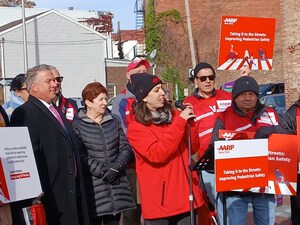Con Ed Utility Shutoff Warnings to Customers Hits Record High - More Than in Great Recession
New Report: Nearly 1M NYC Residents Got Shutoff Notices in 1st 4 Months of '14
NEW YORK, June 17, 2014 /PRNewswire-USNewswire/ -- Nearly 1 million Consolidated Edison customers have faced the threat of having their home energy shut off this year while dealing with some of the nation's highest bills, a new analysis out today from AARP and New York's Public Utility Law Project (PULP) finds. That's more New York City residents at risk of having their power turned off than at even the height of the Great Recession, the analysis shows. Con Ed customers pay more than twice the national average for their electric rates.
In 2005, 722,635 Con Ed customers received shut off notices from January through April, and in 2009 that number soared to 840,886. But during the first four months of this year, on the heels of soaring home energy costs, 937,973 NYC residents have received "final termination notices." Across the State, the data tells a similar story: New Yorkers are struggling, and falling behind in their utility bills by a whopping $740 million - the highest in at least the last decade.
Legislation to create a utility watchdog in the form of an independent utility consumer advocate office, which would help consumers get a better deal when utility companies push for higher rates, is being stonewalled in Albany in the State Senate - as the industry flexes its muscle to kill the AARP-backed bill (S4550B).
"New York has a golden rule when it comes to the utility game: those that have the gold make the rules. Residential consumers get left out of the equation and suffer vastly as a consequence," said Beth Finkel, State Director for AARP in New York State. "We need to change the game in New York to give residential consumers a fair shake, but the industry is doing everything it can to make sure that doesn't happen. Legislation to give consumers a fighting chance has passed the Assembly but is having real problems in the Senate at the hands of Senate Co-Leader Dean Skelos and his conference."
The legislation passed the New York State Assembly last month by a wide margin with a bi-partisan vote and is now being held-up in the Senate Conference led by Senator Dean Skelos; however, the bill is strongly supported by Skelos's Senate majority coalition governing partner, Senator Jeff Klein, and his conference.
A recent AARP survey shows that from Buffalo to Syracuse, Plattsburgh to Poughkeepsie and Manhattan to Montauk, most New Yorkers 50 and older rate the strain of paying their heating bills this past winter as greater than that of paying their mortgages, rent or property taxes.
A 2013 AARP survey of Hispanic voters in New York City age 50 and over found that 73 percent of them are worried about their ability to pay their utility bills, with 31 percent saying that they are extremely concerned.
"Many customers are on payment plans, paying off prior arrears from bills they could not afford," said Gerald Norlander, Executive Director of PULP. "When new bills jump due to the volatile prices favored by the (utility-regulating) Public Service Commission, customers fall behind again and miss the due date for their current bill, plus the installment payment on old arrears. The utility is then allowed to demand all past due amounts, demand late fees, and shut service off as a collection measure. This creates impossible situations, hardships and often hazardous conditions when less safe forms of energy are used. More can and should be done by utilities to make bills more stable and affordable to low-income customers and to minimize service interruption for bill collection purposes."
New Yorkers pay the highest average residential electric rates in the continental United States, nearly twice the national average according to the latest data from the U.S. Energy Information Administration. Con Ed customers pay more than twice the national average. New York is one of only a handful of states, and by far the largest, without an independent advocate for its utility consumers. AARP says that's no coincidence.
Neighboring Connecticut's independent utility consumer advocate reported saving ratepayers $730 million in 2012 at a cost of $3 million – a 243-1 return on investment. California's advocate reported a 153-1 return. Across the United States, utility consumer advocates save Americans billions of dollars a year. AARP says New York should get on board.
Follow us on Twitter: @AARPNY and Facebook: AARP New York
SOURCE AARP New York
WANT YOUR COMPANY'S NEWS FEATURED ON PRNEWSWIRE.COM?
Newsrooms &
Influencers
Digital Media
Outlets
Journalists
Opted In





Share this article